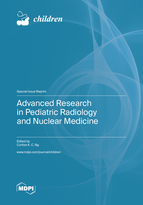Advanced Research in Pediatric Radiology and Nuclear Medicine
A special issue of Children (ISSN 2227-9067).
Deadline for manuscript submissions: closed (5 April 2023) | Viewed by 22156
Special Issue Editor
2. Curtin Health Innovation Research Institute, Faculty of Health Sciences, Curtin University, GPO Box U1987, Perth, WA 6845, Australia
Interests: imaging informatics; radiation dosimetry and protection; medical radiation science education
Special Issues, Collections and Topics in MDPI journals
Special Issue Information
Dear Colleagues,
Advancements in medical imaging modalities including angiography, computed tomography (CT), fluoroscopy, general radiography, interventional radiology, magnetic resonance imaging (MRI), positron emission tomography, single-photon emission computed tomography, and ultrasound have resulted in increasing importance and demand of pediatric radiology. For example, the availability of low-dose CT techniques increases its use in pediatric radiology. Use of artificial intelligence can reduce MRI motion artifacts, and, hence, reducing examination time and needs of sedation and anesthesia, making it more suitable for pediatric patients. These encouraging outcomes rely on researchers to share findings of their advanced research in pediatric radiology and nuclear medicine. I would like to invite you to publish your pediatric radiology and nuclear medicine research findings and/or literature review in the Special Issue, Advance Research in Pediatric Radiology and Nuclear Medicine of the Children journal (Journal Citation Reports 2020 Impact Factor: 2.863) for advancing the pediatric radiology and nuclear medicine practices.
Dr. Curtise Ng
Guest Editor
Manuscript Submission Information
Manuscripts should be submitted online at www.mdpi.com by registering and logging in to this website. Once you are registered, click here to go to the submission form. Manuscripts can be submitted until the deadline. All submissions that pass pre-check are peer-reviewed. Accepted papers will be published continuously in the journal (as soon as accepted) and will be listed together on the special issue website. Research articles, review articles as well as short communications are invited. For planned papers, a title and short abstract (about 100 words) can be sent to the Editorial Office for announcement on this website.
Submitted manuscripts should not have been published previously, nor be under consideration for publication elsewhere (except conference proceedings papers). All manuscripts are thoroughly refereed through a single-blind peer-review process. A guide for authors and other relevant information for submission of manuscripts is available on the Instructions for Authors page. Children is an international peer-reviewed open access monthly journal published by MDPI.
Please visit the Instructions for Authors page before submitting a manuscript. The Article Processing Charge (APC) for publication in this open access journal is 2400 CHF (Swiss Francs). Submitted papers should be well formatted and use good English. Authors may use MDPI's English editing service prior to publication or during author revisions.
Keywords
- artificial intelligence in pediatric radiology
- pediatric angiography
- pediatric computed tomography
- pediatric fluoroscopy
- pediatric interventional radiology
- pediatric magnetic resonance imaging
- pediatric positron emission tomography
- pediatric radiography
- pediatric single-photon emission computed tomography
- pediatric ultrasound







